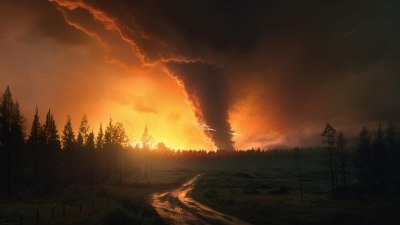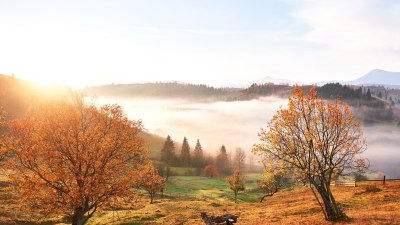Why Snowflakes Never Look Alike The Mind Blowing Science of Ice Crystals
Explore the fascinating science behind why no two snowflakes are alike, uncovering the mysteries of ice crystal formation.

This image was created with the assistance of Freepik
When we think about snowflakes, we often imagine a serene winter scene where each unique flake gently falls from the sky, landing softly on the earth below. It’s a beautiful image, but have you ever stopped to wonder why no two snowflakes are ever exactly alike? This phenomenon, though seemingly simple, is deeply rooted in the intricate science of ice crystals and atmospheric conditions.
The Formation of Snowflakes
The journey of a snowflake begins high up in the atmosphere. Snowflakes form through a process known as ‘nucleation,’ where water vapor in the air condenses and freezes around a tiny particle, such as dust or pollen. Once this initial ice crystal forms, it begins to grow by attracting additional water vapor. As this process continues, the temperature and humidity levels play a crucial role in determining the snowflake’s structure and shape.
Temperature and Humidity Effects
Temperature and humidity are paramount in the growth of snowflakes. As a snowflake falls through varying temperature layers, the changes can dramatically affect its shape. At different altitudes, the temperature and moisture levels can lead to diverse crystal formations. For instance, warmer air typically produces more complex branched structures, whereas colder conditions might result in simpler shapes. The delicate balance of these factors ensures that the shape of each snowflake is unique, even if they originate from the same storm.
The Six-fold Symmetry
Snowflakes exhibit a hexagonal symmetry, a characteristic that emerges from the molecular structure of ice. Each snowflake starts as a simple hexagonal prism, but as it gathers additional water molecules, it grows intricate patterns and arms. This six-fold symmetry is why snowflakes are often categorized into six distinct types: plates, columns, needles, hollow columns, and spatial dendrites. Despite these categories, the complexity of temperature and humidity leads to nearly infinite variations.
Influence of Environmental Factors
When a snowflake falls, it is subject to environmental factors that can alter its growth path. Wind can cause a snowflake to tumble and spin, shifting its orientation and affecting how it collects water vapor. Similarly, slight variations in temperature and humidity from the top to the bottom of the cloud can lead to diverse water molecule attachment points, resulting in unique crystal patterns. The turbulence of clouds means that many snowflakes experience different environmental conditions, further ensuring their uniqueness.
Microphotography and Observation
The incredible diversity of snowflake shapes has fascinated scientists and photographers alike. With advances in microphotography, researchers are able to capture the intricate detail of snowflakes at various temperature and humidity levels. By studying these images, scientists can gain insights into how different conditions affect the formation of crystalline structures. Such research contributes to our understanding of both meteorology and materials science.
Comparing Snowflakes
The assertion that “no two snowflakes are alike” holds true statistically, but with a range of 1038 possible arrangements of molecules, it’s essential to understand just how unique snowflakes can be. Each snowflake's design reflects not only the conditions it experienced during its journey but also the multitude of possible interactions between water molecules. The mathematics behind these structures involves an understanding of crystallography and thermodynamics.
The Role of Water Molecules
Water molecules play a crucial role in the formation of snowflakes. Each water molecule consists of two hydrogen atoms and one oxygen atom (H2O), and their arrangement influences the type of bond formed between molecules. As the snowflake grows, these bonds create the distinct patterns we observe. The angle at which water molecules join together can lead to a variety of shapes—from plates to dendrites—providing insight into the environmental conditions present during growth.
Cultural Significance of Snowflakes
Beyond their scientific intrigue, snowflakes hold cultural significance. They symbolize uniqueness and individuality in various cultures around the world. The phrase “no two snowflakes are alike” has become a metaphor for human experience, illustrating the idea that each person's journey is distinct and invaluable.
Applications in Science
Understanding the formation and characteristics of snowflakes extends beyond mere curiosity. This knowledge has practical applications in several fields. For example, in climate science, researchers study snowflake patterns to better understand precipitation processes and assess water resource management. In materials science, the study of snowflake structures can lead to innovations in manufacturing and nanotechnology.
Snowflakes in Art
Artists and designers are also inspired by the beauty of snowflakes. From intricate decorations during winter to artistic interpretations in various media, snowflakes serve as a muse in the creative world. Their complexity encourages artistic expression, embodying the unpredictability of nature's designs.
The Future of Snowflake Research
As climate change continues to influence weather patterns, the study of snowflakes will only become more relevant. Understanding how snowflakes form under varying atmospheric conditions can provide valuable insights into climate change's effect on precipitation and snowfall. This research could help predict future water availability and inform strategies for adapting to changing climates.
In conclusion, the science behind snowflake formation is a complex interplay of various factors including temperature, humidity, and environmental conditions. Each snowflake’s unique structure emerges from its individual journey through the atmosphere. As we continue to explore the intricacies of these ice crystals, we not only uncover the secrets of nature but also find ourselves inspired by the beauty and uniqueness that surrounds us. So next time you see snowflakes dancing through the air, remember the wonder and complexity that each one carries within its fragile beauty.











